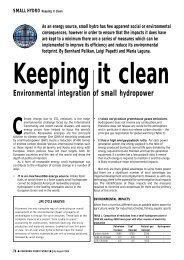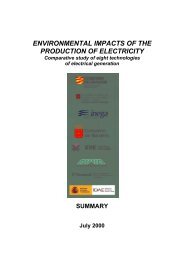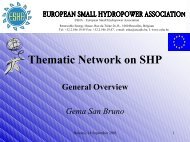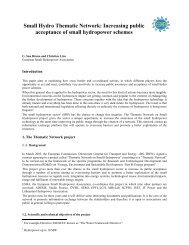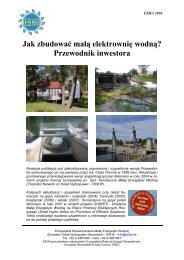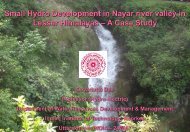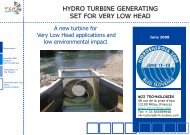HYDRO Tapping small hydro potential - ESHA
HYDRO Tapping small hydro potential - ESHA
HYDRO Tapping small hydro potential - ESHA
You also want an ePaper? Increase the reach of your titles
YUMPU automatically turns print PDFs into web optimized ePapers that Google loves.
<strong>HYDRO</strong> <strong>Tapping</strong> <strong>small</strong> <strong>hydro</strong> <strong>potential</strong><br />
Small <strong>hydro</strong> power is a<br />
clean, sustainable,<br />
efficient and secure<br />
renewable energy source,<br />
combining the advantages of<br />
<strong>hydro</strong> power with those of<br />
decentralized power generation,<br />
but without the disadvantages of<br />
large-scale installations.<br />
Christine Lins and Maria Laguna<br />
make the case for SHP.<br />
Approximately 70% of the earth’s surface is covered<br />
with water, a resource that has been exploited for<br />
many centuries.The exploitation of <strong>hydro</strong> power has<br />
been characterized by continuous technical<br />
development, making it the leading renewable energy<br />
source in the EU. Hydro power now accounts for around 84%<br />
of electricity generated from renewable sources in the EU-15,<br />
and 13% of total electricity production.<br />
This article is limited to <strong>small</strong> <strong>hydro</strong> power (SHP).There is<br />
no consensus on the definition of SHP, but here it will be<br />
defined as any <strong>small</strong> scheme with an installed capacity up to<br />
10 MW. This is the definition adopted by the European Small<br />
Hydropower Association (<strong>ESHA</strong>), the European Commission<br />
and the International Union of Producers and Distributors of<br />
Electricity (UNIPEDE).<br />
SHP has a huge untapped <strong>potential</strong>, offering a<br />
very good alternative to conventional<br />
generation in Europe and the developing world<br />
SHP has a huge, as yet largely untapped, <strong>potential</strong> that<br />
should enable it to make a significant contribution to future<br />
energy needs, offering a very good alternative to conventional<br />
sources of electricity,not only in Europe but also in developing<br />
countries.<br />
INTEREST GROWING<br />
SHP has a key role to play in the development of Europe’s<br />
renewable energy resources, and an even greater role in<br />
developing countries. In the face of increasing electricity<br />
Hidronorte plant in Galicia, Spain: <strong>small</strong> <strong>hydro</strong> is vital to the<br />
development of EU renewable energy sources<br />
162 ● RENEWABLE ENERGY WORLD ● July–August 2004
<strong>Tapping</strong> <strong>small</strong><br />
<strong>hydro</strong> <strong>potential</strong><br />
SHP can make headway
<strong>HYDRO</strong> <strong>Tapping</strong> <strong>small</strong> <strong>hydro</strong> <strong>potential</strong><br />
ABOVE The 500 kW Taojinping SHP project in China’s Zhejiang Province. China is set<br />
to become a <strong>small</strong> <strong>hydro</strong> leader ABOVE RIGHT SHP in Austria; the country ranks third<br />
in EU <strong>small</strong> <strong>hydro</strong> capacity ÖSTERREICHISCHER VEREIN FÜR KLEINKRAFT<br />
demand, international agreements to reduce greenhouse gases<br />
(such as the Kyoto Protocol), environmental degradation from<br />
fossil fuel extraction and use, and the fact that, in many<br />
European countries, large <strong>hydro</strong> power sites have been mostly<br />
exploited, there is an increasing interest in developing SHP.<br />
This trend has been enhanced by the European<br />
Commission’s White Paper on renewable energy 1 and by the<br />
EU Renewable Energy Directive 2 (RES-e Directive), both of<br />
which give a clear signal that the use of renewable energies<br />
must increase in order to reduce environmental impacts and<br />
create a sustainable energy system. The Directive sets<br />
quantified national targets for consumption of electricity from<br />
renewable energy sources,promotes national support schemes<br />
(plus, if necessary, a harmonized support system), simplifies<br />
national administrative procedures for authorization, and<br />
guarantees access to transmission and distribution of<br />
electricity from renewable energy sources. The White Paper<br />
calls for 12% of energy to come from renewables, while the<br />
Directive sets specific goals to reach 22% of electricity use<br />
from renewables in the EU by 2010. For SHP, this means<br />
achieving an ambitious target of 14 GW of installed capacity by<br />
2010 (14 GW, generating 55 TWh of electricity – see Table 1).<br />
As well as setting out a Community strategy and action plan to<br />
double the share of renewable energy from 6% to 12% by 2010,<br />
the White Paper establishes sub-targets for various sectors,<br />
preserves flexibility in how these targets are to be met in view<br />
of Community enlargement, and introduces a tri-annual review<br />
process. The action plan includes internal market measures,<br />
reinforcement of EU policies, and improved co-ordination<br />
between Member States.<br />
TABLE 1. White Paper SHP scenario for 2010<br />
Feature 2010 scenario<br />
Installed capacity > 4500 MW<br />
Electricity generation 55 TWh<br />
Gross energy consumption 4.75 Mtoe<br />
The RES-e Directive gives Member States a reason to look at<br />
SHP because it is the best proven of all renewable energy<br />
technologies. Of special interest for Europe, from both the<br />
economic and environmental point of view, is exploiting the<br />
high <strong>potential</strong> for upgrading and refurbishing existing plants.<br />
164 ● RENEWABLE ENERGY WORLD ● July–August 2004<br />
TABLE 2. SHP financing schemes in individual Member States. Source:<br />
<strong>ESHA</strong>, 2001 3<br />
Country Financing scheme Ownership<br />
Austria Corporate finance Small and large utilities<br />
Germany Private finance Private<br />
Participation finance Limited partnership (GmbH)<br />
Municipalities (Stadtwerke)<br />
Spain Third-party finance Through governmental<br />
organizations<br />
Italy Corporate finance Private investors<br />
Third-party finance Local utilities<br />
The Netherlands Private finance Private<br />
Corporate finance Utilities<br />
Sweden Private finance Partnerships<br />
Corporate finance Private (farmers)<br />
Corporations<br />
As well as the incentives introduced by the Directive, some<br />
financial options favouring SHP have been introduced in<br />
certain Member States.Table 2 shows some of these financing<br />
schemes.<br />
MARKET DEVELOPMENT WITHIN AND OUTSIDE THE EU<br />
Tables 3 and 4 show SHP in the EU-15, the new Member States<br />
(the so-called EU-10) and the three candidate countries. In<br />
2000, there were 14,488 SHP plants in the EU-15, mostly<br />
located in Germany (42.8%), France (11.9%), Austria (11.7%),<br />
Sweden (11.1%) and Italy (10.4%).Almost 45% of these plants<br />
are over 60 years old and 68% are over 40 years old. The<br />
average capacity of an SHP plant in the EU was about 0.7 MW<br />
in 2000, while SHP installed capacity was about 10 GW. This<br />
accounted for 9% of the total installed <strong>hydro</strong> capacity, and<br />
about 2% of all installed electricity capacity.<br />
Electricity production from SHP was about 40 TWh in the<br />
year 2000, accounting for 12% of total electricity produced<br />
from <strong>hydro</strong>, around 10% of all electricity generated from<br />
renewable energy, and about 2% of total electricity generation<br />
in the EU. SHP electricity production has risen by 8% since<br />
1995 (when it was 37 TWh) and is expected to grow by about<br />
38% by 2010 (55 TWh), according to the White Paper.<br />
FUTURE MARKET DEVELOPMENT<br />
This century will witness a major increase in energy<br />
consumption, going hand-in-hand with greater concern about
environmental issues. In this context, SHP has a huge <strong>potential</strong><br />
to meet energy demand with negligible impact on the<br />
environment. Europe has a leading position in the SHP sector<br />
with the best state-of-the-art technology, and is the largest<br />
contributor to installed world capacity and electricity<br />
generation. Nevertheless, there are further technical and<br />
economic challenges to be met.<br />
Outside Europe, there are new opportunities for export<br />
and technology transfer that offer good prospects for EU<br />
<strong>Tapping</strong> <strong>small</strong> <strong>hydro</strong> <strong>potential</strong> <strong>HYDRO</strong><br />
TABLE 3. SHP installed capacity and electricity generation in the EU-15. Sources: Cordis, 2002; 4 <strong>ESHA</strong> sources (national associations); <strong>ESHA</strong>, 2001 3<br />
Member State No. of units SHP installed SHP contribution SHP Contribution SHP electricity SHP contribution<br />
capacity (MW) to EU installed to total <strong>hydro</strong> generation (GWh) to EU electricity<br />
capacity (%) capacity (%) generation (%)<br />
Belgium 82 96 0.61 6.86 385 0.46<br />
Denmark 40 11 0.09 100.00 30 0.08<br />
Germany 6200 1500 1.27 16.67 6500 1.14<br />
Greece 40 69 0.63 2.30 350 0.65<br />
Spain 1106 1607 3.06 9.08 4825 2.14<br />
France 1730 2000 1.73 7.81 7500 1.39<br />
Ireland 45 23 0.48 4.51 96 0.40<br />
Italy 1510 2229 3.12 10.98 8320 3.01<br />
Luxembourg 29 39 3.25 3.55 195 0.22<br />
The Netherlands 3 2 0.01 2.22 1 8.47<br />
Austria 1700 866 4.89 7.53 4246 6.87<br />
Portugal 74 286 2.62 6.36 1100 2.51<br />
Finland 204 320 1.96 11.03 1280 1.83<br />
Sweden 1615 1050 3.20 6.40 4600 3.15<br />
UK 110 162 0.21 3.77 840 0.22<br />
Total 14,488 10,260 1.77 8.67 40,268 1.55<br />
manufacturers. Asia, especially China and India, is set to<br />
become a <strong>hydro</strong> power leader. Present developments in<br />
Australia and New Zealand are focusing on SHP plants. Canada,<br />
a country with a long tradition of using <strong>hydro</strong> power, is<br />
developing SHP as a replacement for expensive diesel<br />
generation in remote, off-grid communities. Markets such as<br />
South America and Africa also have a wide <strong>potential</strong>. Table 5<br />
shows a shortlist of target countries with conditions favourable<br />
for SHP exports.<br />
July–August 2004 ● RENEWABLE ENERGY WORLD ● 165
<strong>HYDRO</strong> <strong>Tapping</strong> <strong>small</strong> <strong>hydro</strong> <strong>potential</strong><br />
TABLE 4. SHP in the EU-10 and candidate countries. Sources: <strong>ESHA</strong>, 2001; 3 2002 World Atlas & Industry Guide; 5 The International Journal on<br />
Hydropower and Dams; 6 <strong>ESHA</strong> internal sources, 2003<br />
Country No. of Installed Electricity Contribution Contribution Potential capacity Potential annual Forecast<br />
plants capacity generation to total <strong>hydro</strong> to total (MW) generation (GWh) 2015<br />
(MW) (GWh) electricity electricity (GWh)<br />
production (%) production (%)<br />
Upgrading New plant Upgrading New plant<br />
Cyprus 1 0.5 – 0 0 – 1 – 0.002 0.002<br />
Czech 1136 250 677 32.3 1.0 10 200 50 1148 1000<br />
Republic<br />
Estonia 13 3.0 10 100 0.1 2 2 6 6 50<br />
Hungary 35 8.6 38 25.4 0.1 2 22 9 90 106<br />
Latvia 57 1.7 14 0.5 0.3 36 60 90 150 152<br />
Lithuania 29 9.3 30 3.6 0.2 3 40 11 186 100<br />
Malta 0 0 0 0 0 0 0 0 0 No<br />
forecast<br />
Poland 472 127 705 31.0 0.5 320 1600 1300<br />
Slovakia 180 31 175 3.8 0.7 23 37 120 178 350<br />
Slovenia 413 77 270 7.6 2.3 10 180 50 780 900<br />
Bulgaria 64 141 412 22.3 1.0 – – – – 1000<br />
Romania 9 44 287 1.8 0.5 – – – – 300<br />
Turkey 67 138 500 1.7 0.4 – – – – 2800<br />
The greatest impetus for <strong>small</strong> <strong>hydro</strong> development is<br />
currently coming from Asia, including China and India (see<br />
Figure 1).This region has the best resources and a major need<br />
for power – and is the recipient of large amounts of financial<br />
support for rural electrification, backed by government<br />
initiatives. Latin America also has good <strong>potential</strong> for <strong>hydro</strong><br />
development,but several countries have significant oil reserves<br />
that are keeping <strong>small</strong> <strong>hydro</strong> lower down the political agenda.<br />
Eastern Europe, including the former Soviet nations, is also<br />
now becoming a strong <strong>potential</strong> market.<br />
Looking to the future there are good reasons to support<br />
<strong>small</strong> <strong>hydro</strong> power:<br />
• the depletion of oil and natural gas deposits will lead to<br />
higher generation costs for thermal plants<br />
Output (TWh/year)<br />
8000<br />
7000<br />
6000<br />
5000<br />
4000<br />
3000<br />
2000<br />
1000<br />
0<br />
Africa<br />
Asia<br />
Australasia/<br />
Oceania<br />
Technical <strong>potential</strong><br />
Europe<br />
Exploited <strong>potential</strong><br />
166 ● RENEWABLE ENERGY WORLD ● July–August 2004<br />
North & Central<br />
America<br />
South<br />
America<br />
Economic <strong>potential</strong><br />
FIGURE 1. Total <strong>hydro</strong> power <strong>potential</strong> by continent. Source: <strong>ESHA</strong>, 2002 8<br />
TABLE 5. Target countries with favourable conditions for SHP exports.<br />
Source: <strong>ESHA</strong>, 2003 7<br />
Region Time frame Countries for consideration<br />
Latin America Short to medium Brazil, Peru, Argentina, Ecuador,<br />
term Colombia<br />
Africa Immediate Uganda<br />
Central and Short to medium Slovakia, Czech Republic,<br />
Eastern Europe term Ukraine, most independent<br />
former USSR states<br />
Asia (excluding Short to medium Nepal, Thailand, Sri Lanka,<br />
India and China) term Philippines, Indonesia, Laos,<br />
Vietnam<br />
Other Immediate India, China, Russia, Caribbean,<br />
Cuba<br />
• by offsetting thermal generation, <strong>small</strong> <strong>hydro</strong> power is a<br />
leading technology in efforts to reduce greenhouse gases<br />
– with the introduction of carbon trading, thermal plant<br />
will become more expensive<br />
• high-voltage direct current transmission over long<br />
The greatest impetus for <strong>small</strong> <strong>hydro</strong><br />
development is currently coming from Asia,<br />
including China and India<br />
distances is becoming cheaper and electricity networks<br />
are getting interconnected and growing<br />
• the growth of the world’s population, especially in<br />
developing countries, will require the appropriate<br />
infrastructure for irrigation and water supply; the addition<br />
of a <strong>hydro</strong> power component to such a project is<br />
economic and has no major environmental or social<br />
impacts
Capacity (MW)<br />
14,000<br />
13,000<br />
12,000<br />
11,000<br />
10,000<br />
9000<br />
8000<br />
7000<br />
6000<br />
10,212<br />
10,319<br />
10,718<br />
2000 2001 2003 2010<br />
Year<br />
Current trend White paper<br />
FIGURE 2. Comparison of the current trend with the White Paper<br />
objectives. Source: EurObserv’ER 2003 9<br />
• it is widely believed that, as part of the long-term changes<br />
in the energy sector, <strong>hydro</strong>gen is the fuel of the future;<br />
remote <strong>hydro</strong> can also become one of the major carbonfree,<br />
financially viable producers of <strong>hydro</strong>gen.<br />
TARGETS FOR FUTURE MARKET DEVELOPMENT<br />
12,000<br />
Following the current trend, Figure 2 shows that the SHP<br />
sector will not completely reach the targets set in the White<br />
Paper. This is mainly due to long and complicated licensing<br />
procedures for new installations. Increased political support<br />
for SHP, as well as an emphasis on exploiting the high level of<br />
<strong>potential</strong> for upgrading and refurbishing existing plants, is<br />
needed in order to achieve the targets.<br />
At present, numerous institutional barriers still stand in the<br />
way, mainly resulting from the difficulties inherent in gaining<br />
permission to abstract water from rivers, but also due to the<br />
perception that <strong>hydro</strong> plant adversely affect fishing.Difficulties<br />
in gaining affordable connections to the grid are also common,<br />
although this situation is tending to improve.<br />
BELOW An SHP facility in Sweden, a country in the European <strong>small</strong> <strong>hydro</strong> ‘top five’<br />
SERO BELOW RIGHT Fish-friendly turbine in Versoix, Switzerland MHYLAB<br />
<strong>Tapping</strong> <strong>small</strong> <strong>hydro</strong> <strong>potential</strong> <strong>HYDRO</strong><br />
At the same time, pressure from environmental groups –<br />
which can oppose SHP for its negative local environmental<br />
impacts on river ecosystems – hinders progress in many<br />
developed countries. Sometimes no distinction is made<br />
between the impact of large <strong>hydro</strong> and that of <strong>small</strong> <strong>hydro</strong><br />
schemes. Such opposition is often related to specific cases and<br />
should not be applied to SHP across the board. However, new<br />
technology and improved methods of operating SHP are<br />
steadily reducing its adverse environmental impacts, while<br />
involving local communities in the planning, design and<br />
management process is helping to change negative<br />
perceptions of SHP.<br />
Small <strong>hydro</strong> power offers one of the most<br />
practical and immediately realizable routes to<br />
expanding use of renewable energy sources<br />
The SHP industry has been affected by exaggerated<br />
criticisms of negative environmental impacts which ignore its<br />
important environmental and social benefits. These benefits<br />
include the replacement of fossil fuels – thus reducing<br />
greenhouse gas emissions, air pollution and resource depletion<br />
– and boosting the local economy of isolated populations.<br />
Since SHP provides autonomous and reliable energy, it is<br />
suitable for co-operative or communal ownership, and<br />
combined with irrigation systems, it is an appropriate solution<br />
in developing countries. In the last few years, much emphasis<br />
has been put on the environmental integration of SHP plants<br />
into river systems in order to minimize impacts to the<br />
ecosystem and enhance the quality of the aquatic<br />
environment.<br />
The EU’s clear commitment to renewables and climate<br />
protection, which is reflected, for instance, in the RES-e<br />
Directive and the bloc’s ratification of the Kyoto Protocol, is<br />
expected to provide further stimulus for the SHP sector within<br />
the Member States. Based on this strong domestic market, EU<br />
turbine manufacturers should have a sound policy framework<br />
for promoting their products on the global market.<br />
July–August 2004 ● RENEWABLE ENERGY WORLD ● 167
<strong>HYDRO</strong> <strong>Tapping</strong> <strong>small</strong> <strong>hydro</strong> <strong>potential</strong><br />
Small <strong>hydro</strong> in France, second only to Germany amongst the EU nations in terms of<br />
installed SHP ADEME<br />
FRAMEWORK CONDITIONS FOR SUSTAINABLE MARKET<br />
DEVELOPMENT<br />
Small <strong>hydro</strong> power offers one of the most practical and<br />
immediately realizable routes to expanding the use of<br />
renewable energy sources in Europe,at the same time boosting<br />
exports by strengthening the technically advanced European<br />
<strong>small</strong> <strong>hydro</strong> manufacturing industry. However, SHP does not<br />
have a very favourable regulatory framework, and official<br />
support for the technology is generally limited. Awareness of<br />
<strong>small</strong> <strong>hydro</strong>’s benefits and the need to develop a more<br />
objective view of its true environmental impact are therefore<br />
both essential components in future strategies to develop its use.<br />
Hydro represents a long-established<br />
technology – but that does not mean there is<br />
no more room for technical development<br />
Effective and realistic standards for meeting requirements<br />
to minimize any environmental problems are needed, whilst<br />
tariff rates on offer to SHP owners and developers for the<br />
purchase of electricity should reflect the technology’s low<br />
environmental impact and high <strong>potential</strong> performance.<br />
The initial strategic requirements are for <strong>small</strong> <strong>hydro</strong> to<br />
feature more prominently in national and EU energy planning,<br />
with a view to its stronger encouragement.The regulatory and<br />
financial framework for SHP needs to be improved and,<br />
wherever possible, harmonized across the EU. Contrary to<br />
popular mythology, the fact that <strong>hydro</strong> represents a longestablished<br />
technology does not mean there is no further room<br />
for technical development.A resurgence of <strong>small</strong> <strong>hydro</strong> power<br />
development in Europe needs to be backed by technical<br />
improvements.<br />
A sustainable market for SHP requires a number of<br />
conditions:<br />
• Energy policy framework – Member States should<br />
168 ● RENEWABLE ENERGY WORLD ● July–August 2004<br />
develop energy policies that clearly set out objectives<br />
regarding the development of power generation options,<br />
including <strong>small</strong> <strong>hydro</strong> power.<br />
• Decision-making process – governments should establish<br />
an equitable, credible and effective environmental<br />
assessment process that takes into account both<br />
environmental and social concerns, with a predictable and<br />
reasonable schedule.<br />
• Comparison of <strong>small</strong> <strong>hydro</strong> power project alternatives –<br />
project designers should apply environmental and social<br />
criteria when comparing project alternatives in order to<br />
eliminate unacceptable schemes early in the planning<br />
process.<br />
• Improving environmental management of plants –<br />
project design and operation should be optimized by<br />
ensuring the proper management of environmental and<br />
social issues through the project cycle.<br />
• Sharing benefits with local communities – communities<br />
should benefit from local SHP projects, both in the short<br />
and the long term.<br />
Small <strong>hydro</strong> power represents a clean alternative to fossil<br />
fuel electricity generation. However, developing the remaining<br />
<strong>hydro</strong> power <strong>potential</strong> offers many challenges, and pressure<br />
from some environmental action groups over the impact of<br />
SHP schemes has tended to increase over time. Moreover, in<br />
the context of the restructuring of the electricity sector,<br />
markets may favour more polluting and less costly options.<br />
Christine Lins is Secretary General of the European Small Hydropower<br />
Association in Brussels, Belgium, and Maria Laguna is the Project<br />
Manager at <strong>ESHA</strong>.<br />
Fax: +32 2546 1947<br />
e-mail: esha@arcadis.be<br />
maria.laguna@esha.be<br />
website: www.esha.be<br />
REFERENCES<br />
1. European Commission. Energy for the future: Renewable sources of energy.<br />
White Paper for a Community Strategy and Action Plan. COM(97)599 final.<br />
Brussels. 1997.<br />
2. Directive 2001/77/EC on the promotion of electricity produced from renewable<br />
energy sources in the internal electricity market. OJ L 283, 27.1.2001<br />
3. <strong>ESHA</strong>. BlueAGE: Blue Energy for A Green Europe. Strategic Study for the<br />
Development of Small Hydro Power in the European Union. 2001.<br />
4. Cordis – www.cordis/lu/eesd/src/indicators.htm<br />
5. 2002 World Atlas and Industry Guide International Journal on Hydropower &<br />
Dams. Sutton: Aqua~Media International Ltd. 2003.<br />
6. The International Journal on Hydropower and Dams (www.<strong>hydro</strong>powerdams.com)<br />
7. Target countries with favourable conditions form <strong>small</strong> <strong>hydro</strong>power exports.<br />
<strong>ESHA</strong>. 2003.<br />
8. <strong>ESHA</strong>. Discussion Paper on the Comparison of Compensation Systems for<br />
Electricity for Renewables. 2002<br />
9. Observ’ER. EurObserv’ER: European Barometer 2001. Renewable Energy<br />
Overview. 2002.<br />
FURTHER READING<br />
Renewable Energy in Europe. Building Markets and Capacity. EREC. 2004.





